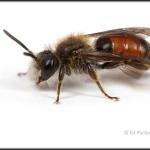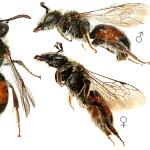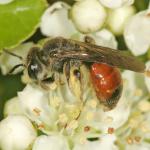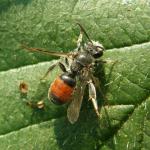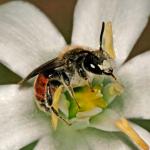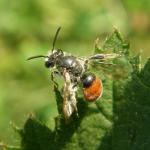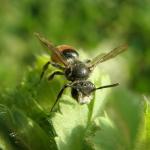Andrena cingulata Fabricius, 1775.
A small mining bee with a largely red gaster in both sexes, very reminiscent of certain bees of the genus Sphecodes (Halictidae). The male has a yellow clypeus and lower paraocular areas.
Throughout suthern England to north Yorkshire and Wales. Very local and mainly confined to sandy soils both on the coast and inland. There are no records from Ireland, but the species does occur in the Channel Islands. This species declined greatly in the period 1950-1990 but has since become much more frequent. On mainland Europe the range of this species extends from southern Fennoscandia to Spain, northern Italy and Bulgaria. There are also published reports from Turkey, the Caucasus, Kazakhstan, Iran, northern Manchuria and Morocco.
Listed as Rare (RDB3) in Shirt (1987) but changed to Nationally Scarce (Na) by Falk (1991).
Predominantly open grassland and edges of scrub and woodland.
Univoltine; early May to late June.
Nests either occur singly or in compact aggregations. In Yorkshire, Cooper (1947) estimated that there were several hundred freshly-emerged adult bees in the dry soil of a fairy ring he excavated in September (the soil being white with the mycelium of the fungus). Very few individuals were found either within or outside this narrow ring, the soil in these areas being rather wet. The species has also been reported to overwinter as an adult in its natal cell (Box, 1919).
Apart from those species listed above, the bee also visits dogwood (Cornus sanguinea), hawthorn (Crataegus monogyna), horseshoe vetch (Hippocrepis comosa), kidney vetch (Anthyllis vulneraria), meadowsweet (Filipendula ulmaria) and willow (Salix spp.).
2005


